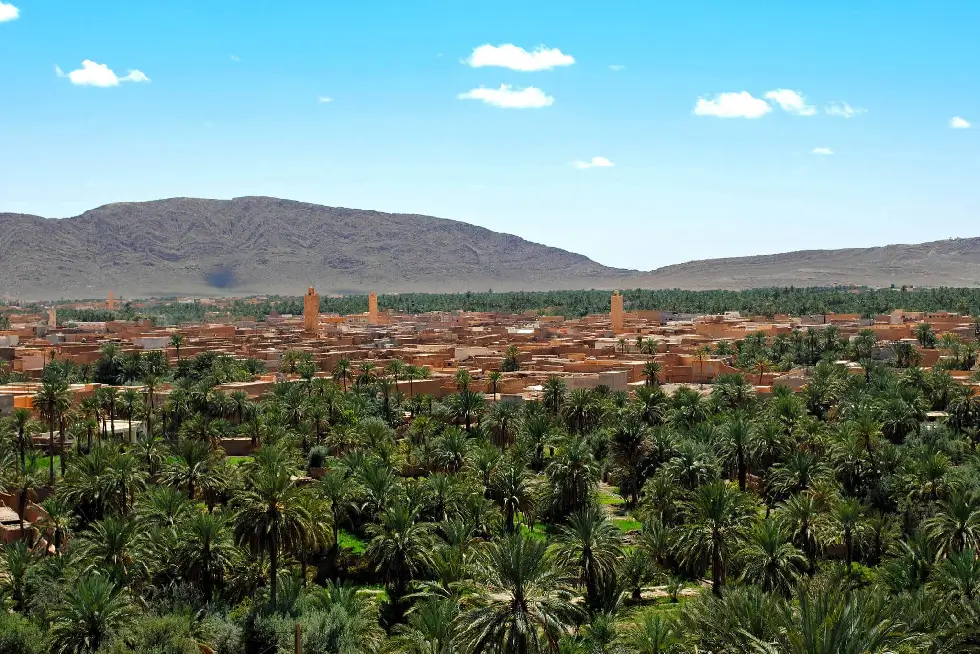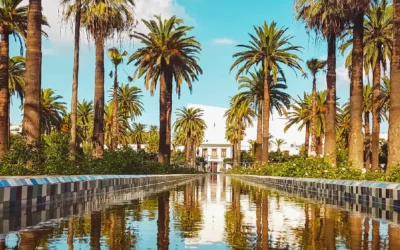Figuig / Figig Town: The Eastern Oasis of Morocco, Between Sands & Palms

Table of Contents:
Introduction to Figuig Town
Figuig / Figig is a captivating oasis town in the Oriental region of northeastern Morocco, close to the Sahara Desert and the Atlas Mountains. It’s known for its large oasis of date palms.
The town is high up, about 3,000 feet above sea level, and has seven historic walled villages. its people speak a mix of Berber and Arabic languages. The town has a diverse community, including religious leaders and agricultural workers.
Figuig was once an important stop for travelers and traders going through Morocco. It has had some economic challenges, especially after the nearby border with Algeria closed in 1994.
But, it’s still known for its traditional crafts like textiles and carpets, and especially for its dates. The town has kept its historic irrigation systems, which helps maintain its traditional look and feel.
Figuig Discovery Tour
Figuig, with its unique oasis setting, offers a range of attractions for visitors to explore. Some of the most noteworthy places to visit in Figuig include:
1. Qsr aljwabr
Dive into history at Qsr aljwabr, where the ancient ruins reveal the region’s architectural marvels and rich past. This site is a must-see for those eager to connect with the ancient stories etched into the landscape of Figuig.
2. Qsr awlad mhrz
Much like Qsr aljwabr, Qsr awlad mhrz invites visitors to step back in time. Here, the ruins offer a fascinating journey through Figuig’s historical layers, making it an essential stop for history enthusiasts.
3. Qsr l bydat ayt alnj
Continue your historical exploration at Qsr l bydat ayt alnj. This site adds another dimension to Figuig’s cultural tapestry, offering insights into the town’s vibrant past.
4. Bhbwht
Complete your tour of Figuig’s historical landmarks at Bhbwht. This location enriches the array of cultural and historical experiences in Figuig, providing a comprehensive understanding of the town’s heritage.
These attractions, primarily ruins and historical sites, provide a window into Figuig’s storied history and the lifestyles of its ancient inhabitants.
For those interested in uncovering the mysteries of history, architecture, and the unique cultural blend of this Moroccan oasis town, these sites are unmissable.
Figuig Accessibility And Transportation
1. Scenic Routes to an Oasis Town
The primary access to Figuig is via road, with the journey from Oujda, a major city about 368 km to the north, unfolding across a picturesque Moroccan landscape.
As you approach Figuig, you’re greeted with breathtaking panoramic views of its fortress, lush palm groves, and the majestic mountains that frame the town.
2. Exploring Figuig on Foot
Within Figuig, local transport options may be sparse, but this opens up a wonderful opportunity to explore the town on foot.
Wandering through its ancient ksars and tranquil palm groves lets you fully immerse in Figuig’s peaceful ambiance and observe the local life up close.
3. An Adventurous Approach
Traveling to and within Figuig is an adventure due to its remote setting. Perched nearly 3,000 feet above sea level in the Wadi Zousfana basin and almost encircled by the Algerian border, Figuig offers a unique destination off the beaten path.
Its location makes it a less common, yet intriguing choice for travelers.
4. A Hidden Gem Worth the Journey
In summary, Figuig is a treasure for those seeking a unique experience, rich in both history and natural beauty. While getting there might need some planning, the journey and the experience of discovering this distinct oasis town are truly rewarding.
Modern Figuig and its Economic Significance
1. Agricultural Heartland
Figuig, an oasis town near Morocco’s Algerian border, thrives on its agricultural prowess. The town’s palm groves, especially its date palms, are not just a beautiful sight but a crucial economic pillar.
These palms and other crops, nurtured by traditional irrigation from mountain aquifers, form the backbone of Figuig’s economy, providing sustenance and income to the locals.
2. Shifting Trade Dynamics
Once a bustling hub in the trans-Saharan trade routes, Figuig’s trade landscape transformed with the closure of the Moroccan-Algerian border in 1994.
This shift posed challenges, but Figuig’s community showed remarkable adaptability, seeking new growth opportunities beyond traditional markets.
3. Tourism and Handicrafts: New Economic Horizons
The town’s unique architecture and lush palm groves have turned it into an attractive destination for eco-tourism and cultural tourism. This new interest has spurred growth in hospitality and related services, creating fresh economic avenues.
Furthermore, Figuig’s local handicrafts, like carpets and pottery, blend traditional and modern designs, adding another layer to its economic diversification.
4. Sustainable Practices and Local Governance
Figuig’s journey towards economic diversification is underscored by a commitment to sustainable practices and local business promotion.
This approach, guided by insightful local governance, has been instrumental in building a diverse and resilient economy.
In essence, Figuig stands as a beacon of economic resilience and innovation. Its journey from a traditional agricultural base to a diverse economy embracing tourism and handicrafts illustrates its adaptability and enduring significance in Morocco’s economic story.
Figuig History Overview
Figuig, a region rich in history, has been shaped by diverse cultural and imperial influences. Initially, Christianity dominated the area before Islam’s arrival in the 7th century. This major shift in the religious landscape was partly influenced by Christian pilgrims on their way to Jerusalem.
1. Diverse Rule and Resistance
Over the centuries, Figuig has witnessed a myriad of ruling powers. Various dynasties have left their mark on the town, and it was also impacted by French colonization.
Notably, Figuig was not just a passive observer; it played a significant role in resisting foreign dominance, particularly during the early 20th century’s French colonial era.
2. Innovative Water Management
A key aspect of Figuig’s heritage is its innovative water management practices. The Jmāa, a local governing body, oversees water rights, ensuring fair distribution and sustainability.
This practice is vital for resource preservation and highlights the community’s commitment to sustainable development.
3. A Fusion of History and Tradition
Figuig stands out for its historical depth, unique agricultural methods, and distinctive architectural heritage. These elements make Figuig an intriguing and important area of study in both Moroccan and North African history.
Conclusion
The oasis town of Figuig presents a remarkable blend of tradition and modernity. Known for its scenic landscapes and rich cultural heritage, while preserving its unique oasis environment and traditional practices, Figuig stands as a testament to adaptability and sustainable living.
Its story reflects the enduring spirit of a community deeply rooted in its history yet dynamically evolving to meet contemporary needs.
FAQ
What languages are spoken in Figuig?
The people of Figuig speak a mixture of Berber and Arabic languages.
How does Figuig manage its water resources?
The town employs traditional irrigation systems managed by the Jmāa, a local governing body, ensuring sustainable use and fair distribution of water resources.
What is Figuig / Figig?
Figuig is an enchanting oasis town located in northeastern Morocco, known for its large oasis of date palms, rich history, and traditional crafts.
Where is Figuig located?
Figuig is situated in the Oriental region of Morocco, close to the Sahara Desert and the Atlas Mountains, approximately 3,000 feet above sea level.
What is the historical importance of Figuig?
Figuig was once a crucial stop for travelers and traders in Morocco. It has a storied past marked by various cultural influences and was known for its resistance during the French colonial era.
How has Figuig’s economy evolved?
Historically a hub in trans-Saharan trade routes, Figuig faced challenges after the Moroccan-Algerian border closure in 1994. However, it has since adapted, focusing on agriculture, eco-tourism, and handicrafts.
What are the main attractions in Figuig?
Key attractions include historical sites like Qsr aljwabr, Qsr awlad mhrz, Qsr l bydat ayt alnj, and Bhbwht. These places offer insights into Figuig’s rich history and cultural heritage.
Can Figuig be explored on foot?
Yes, exploring Figuig on foot is recommended to fully experience the town’s tranquil ambiance and observe local life closely.
How can one travel to Figuig?
Figuig is primarily accessible via road. The journey from Oujda, a major city in the north, offers scenic views of the Moroccan landscape, including Figuig’s fortress and palm groves.
What makes Figuig a unique travel destination?
Figuig’s remote setting, historical significance, and unique oasis environment make it an intriguing choice for travelers seeking off-the-beaten-path experiences.
What is the economic significance of Figuig today?
Figuig thrives on agriculture, particularly date palms, supplemented by eco-tourism and the sale of local handicrafts like textiles and pottery. It’s a model of economic resilience and adaptability.
What makes Figuig a special place to visit?
Figuig stands out for its blend of tradition and modernity, scenic landscapes, rich cultural heritage, and commitment to sustainable living. It offers a unique glimpse into the life of a traditional Moroccan oasis town while embracing contemporary needs.



